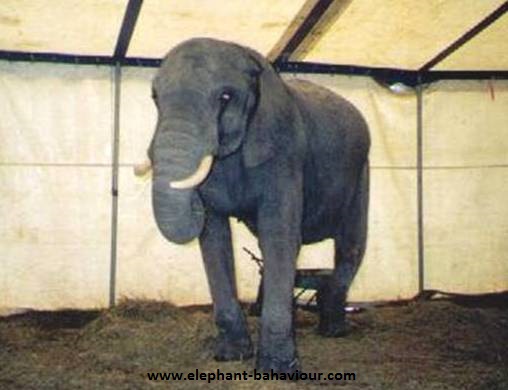Elephants in Circus
Facts about the problems of african elephants in Circusses:* (Abstract):
*Results from a investigation of 42 elephants into 17 german circusses.

An African elephant cow in a circus-tent. Photo: T. Dornbusch
- Low life expectancy:
Most african elephants in circus die before they are in the age of 30 years.
- Stereotypy:
100 % of the investigated african elephants shows stereotypic behaviour. This is an sign of low welfare conditions. After many yeras the behaviour becomes irreversible.
Orginal source: DORNBUSCH T. 2012. Gedanken eines Biologen zur "artgerechten Haltung", 2. Teil: Stereotypien. Elefanten in Zoo und Circus. Das Elefanten-Magazin 22: 36 - 37.
http://elephant-behaviour.com/data/documents/22_biologengedanken_stereotypien_2012.pdf
- Bad care status:
40 % of the african elephants in circusses showed a poor care-condition.
- Deformed hind legs:
17 of 42 elephants had deformed hind legs (40 %).
- Growth retardation:
76 % of the african elephants in circusses were smaller as elephants in the same age in the wild.
Original source:
DORNBUSCH T. 2011. Haltungsbedingte Probleme Afrikanischer Elefanten im Circus. Elefanten in Zoo und Circus. Das Elefanten-Magazin 20: 51 - 55.
http://elephant-behaviour.com/data/documents/20_Circusafrikaner_Folgeschaeden_2011.pdf
Stereotypic behaviour of zoo- and circuse-elephants.
Behavioural data were collected from fourten elephants, four circus-elephants (tree african and one asian) and ten zoo-elephants (seven african and three asian) in different zoos and circusses.
The zoo-elephants: Three elephants show no stereotype (30 %), among them two captive born elephants and one wild born. Another, subadult captive born elephant showed at the beginning stereotypic “weaving”, but no longer after the restructuring of the enclosure and an improved Enrichment-program. Six elephants show regularly stereotypes (about 15,15% of their behaviour), among them two captive born elephants. Two of them show two forms of stereotype: constant back and forth walking of the same route, and “weaving” the head. The other four elephants show mainly just the swinging of the head (“weaving”). The lowest value of stereotype behaviour was 0% (for three elephants), and the lowest of an steretypic elephant was 2,8 %. The hightest value of stereotypiv behaviour was around 24 % (but this was a former circus-elephant, which life in a zoo, now).
The average proportion of stereotype from the ten zoo-elephants togther was 9,09 %.
The circus-elephants: All four elephants show stereotypic behaviour (100 %). One african show two forms of stereotypes: constant back and forth walking of the same route, and the "weaving". The other three elephants show just the "weaving". The lowes value of stereotype behaviour was around 20 % for one elephant (allmost the same, like the highest value for an zoo-elephant), and the highest value of steretype hebaviour was more than 75 %.
The average proportion of stereotype from the four circus-elephants was around 60 %.
Original source: DORNBUSCH T. 2016. Untersuchungen der Stereotypie bei Zoo- und Circuselefanten. Elefanten in Zoo und Circus. Das ELefanten-Magazin. 28: 77 - 79.
http://elephant-behaviour.com/data/documents/28_StereotypieElefanten_VergleichZooCircus_2016.pdf
For more information about elephants write me an e-mail, please.

